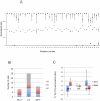Investigation of parameters that affect the success rate of microarray-based allele-specific hybridization assays
- PMID: 21445337
- PMCID: PMC3062541
- DOI: 10.1371/journal.pone.0014777
Investigation of parameters that affect the success rate of microarray-based allele-specific hybridization assays
Abstract
Background: The development of microarray-based genetic tests for diseases that are caused by known mutations is becoming increasingly important. The key obstacle to developing functional genotyping assays is that such mutations need to be genotyped regardless of their location in genomic regions. These regions include large variations in G+C content, and structural features like hairpins.
Methods/findings: We describe a rational, stable method for screening and combining assay conditions for the genetic analysis of 42 Phenylketonuria-associated mutations in the phenylalanine hydroxylase gene. The mutations are located in regions with large variations in G+C content (20-75%). Custom-made microarrays with different lengths of complementary probe sequences and spacers were hybridized with pooled PCR products of 12 exons from each of 38 individual patient DNA samples. The arrays were washed with eight buffers with different stringencies in a custom-made microfluidic system. The data were used to assess which parameters play significant roles in assay development.
Conclusions: Several assay development methods found suitable probes and assay conditions for a functional test for all investigated mutation sites. Probe length, probe spacer length, and assay stringency sufficed as variable parameters in the search for a functional multiplex assay. We discuss the optimal assay development methods for several different scenarios.
Conflict of interest statement
Figures





References
-
- Zhang L, Miles MF, Aldape KD. A model of molecular interactions on short oligonucleotide microarrays. Nature Biotechnology. 2003;21:818–821. - PubMed
Publication types
MeSH terms
LinkOut - more resources
Full Text Sources
Other Literature Sources

